A Guide To Building A Wine Room - Best Ideas
Posted by Wine Coolers on 12th May 2025
Wine cellars or wine rooms are a wonderful idea to store and preserve your wine for a long period. Building a wine room is not a luxury, but an essential investment for a wine enthusiast. A wine room is a particular space designed to store, preserve, showcase, and elevate a wine collection. It can create an ideal environment allowing wine to age and preserve its quality over time. Whether you are designing a wine cellar in a house, shop, restaurant, or any private space, it needs careful planning and expertise. In this guide, we’ll walk you through creating the perfect wine room.
Why Do You Need A Wine Room?
A wine room is a proper storage area for your wines, ensuring your wine collection remains in optimal condition, while also offering a space for enjoyment. Wine requires precise temperature and humidity control for appropriate ageing. A dedicated Wine cellar at home enables you to constantly control these environments, guaranteeing the wine ages gracefully and maintains its flavour profile.
Preserving wine without spoiling its aroma, flavour, and texture for a long period will not be a hectic task if stored in a wine room. Designing wine cellar can be a safe investment that can protect your precious wine varieties. Aesthetically showcasing your wine collection and having a sip in the middle of that can be real with a wine room setup. Displaying your wine bottles in a visually pleasing way and being able to access them easily for tasting or entertaining is a true luxury.
If you are a wine enthusiast with a wide collection of wines, vintage collections, expensive bottles, rare bottles, or even if you want to start a collection on a large scale. Considering wine rooms for a large wine collection would never be a bad investment, but it helps to preserve the integrity of those wines.
Considerations Before Starting Wine Cellar Design
Creating favourable conditions and a climate for wine preservation is the foremost consideration while planning to build a wine room. Perfect balancing of temperature, humidity, lighting, and location can work magic on wines, while they act vice versa when not balanced. These are the four major key elements that determine the quality and perfection of wines.
1. Temperature
Maintaining a constant optimal temperature can help the wine to get refined. Temperature within 13-15°C is preferred to attain better results and avoid sudden swings in temperature from central heating systems. You may be thinking of what happens even if the temperature is not always ideal. The answer is simple, it ages too fast when it is too hot and slows down the ageing process when it is too cold. And, if it is very cold, of course, your wine will freeze.
Consider using a dedicated regulator with an easy-to-read digital display to monitor the temperature. The cooling system has to work 24/7 without any power interruption and it's essential to consider the energy costs associated with keeping your wine room at the right temperature.
2. Humidity
Wine rooms often use a humidity control system with around 60-70% humidity to maintain the moisture level. This controls the moisture inside the cellar and prevents the cork from drying out, which may cause leakage or spoiling of the wine. Some cooling systems come with built-in humidifiers, if not, consider adding an external humidification system to your wine room. This will maintain the right moisture levels and ensure your corks stay intact, keeping your wine in excellent condition.
3. Lighting
The primary requirement for a wine cellar at home or any other space is to avoid direct sunlight that damages your wine with Ultraviolet(UV) Rays. To prevent heating and early ageing, use dim or indirect LED lights in the wine room. Ambient lights in the room and display racks elevate the interior, providing an elegant classic style.
4. Location
A wine can be set up in any room by renovating it into a cool, dark place. An ideal place to make a wine room is an area with minimal temperature variations. If you do not have a dedicated space like this, you can easily renovate any room or wall to make it a heaven of wines. Preferably, the most popular wine rooms are places like a basement, under the stairs, pantry, or hall closet.
Select a room to create a wine cellar at home or basement or anywhere; that contains proper ventilation with at least one door, window, or air vent to allow the warm air to escape. Transform any room into a wine sanctuary with the right insulation and cooling system.
High Vs Medium Budget Cellars
Wine cellars can be constructed as high-end or budget-friendly wine rooms, depending on your budget. Variations in construction, arrangement, quality of materials, climate control, and customisation are the factors that influence the budget.
- High Budget Wine Cellars
When you need a high-end, luxurious home wine cellar for your precious wine varieties, you can choose the best quality construction materials and beautifully customise the design of the display shelves. Luxurious wine rooms are built with premium materials such as oak or redwood cabinetry, brass fixtures, stainless steel or glass racks, stone or custom-made flooring, and aesthetically pleasing lighting.
Advanced cooling control systems and high-quality climate control units ensure precise temperature and humidity regulation to preserve wine over the long term. Dual temperature zone settings allow you to keep various wine varieties in their suitable environments. These wine cellars typically have large capacity and storage space, with separate display sections and storage units. They may even have tasting and preparation areas, making them the perfect haven for wine.
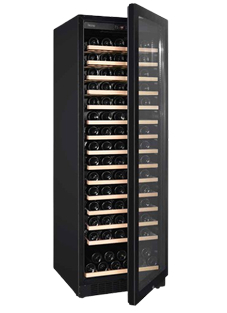
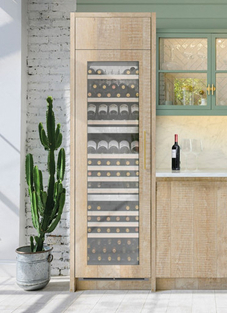
- Medium Budget Wine Cellars
If you prefer not to go for something too luxurious, there are many options to build a medium-budget home wine cellar. Though these models are cost-effective and practical, they can still be made with decent quality materials. Simple wine cellars can be created in smaller spaces, such as a garage, utility room, or even under the stairs. Affordable designs using pine wood walls, metal racks, basic flooring, or simple tiles can reduce the budget, yet still allow you to create a great wine storage area.
Using less expensive basic cooling systems or off-brand units can help lower your costs. Prefer a single-zone cooling system if you plan for general wine storage, although a dual-zone system will be better for long-term preservation. Focus more on practicality than aesthetics and design to reduce expenses for a budget-friendly wine cellar at home.
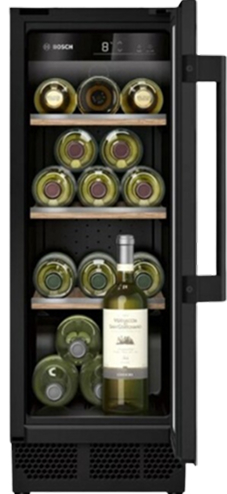

Decide On Which Materials You Want
Building a traditional or modern-style wine cellar depends on your preferences and choices. Once you have decided on the plan and style of the wine cellar, you may wish to consult a professional to work on it. The materials required for the construction depend on the model you choose and the budget you allocate. Remember, the materials you choose for the cellar can impact both its look and its ability to preserve your wine collection.
Select the appropriate framing material to balance temperature, humidity, and ventilation, ensuring proper storage and functionality. Wood is the classic choice for those opting for a traditional framing method, including pine, redwood, and mahogany.
Wood has been given prime priority because it insulates well and helps to stabilise the temperature and humidity. Stone or brick can also be used for traditional wine cellars, while stone walls and flooring could enhance the ambience by providing a raw or cave-like environment.
Glass panels and stainless steel racks often give a sleek, modern look to the cellar. However, glass doesn’t provide any insulation like wood or stone framing. But advanced cooling systems can compensate for this issue, and glass panels offer a minimalist, stylish interior, making it easier to showcase the wine collection.
Stainless steel racks and concrete are used in modern designs to create a minimalist, industrial feel. Polished floors also add a contemporary touch to the interior, and maintenance is not a hassle.
Steps For Building Your Wine Cellar
Once you have finalised your preferences, style, materials, budget, and location, you can start constructing your wine cellar.
1. Sealing & Flooring
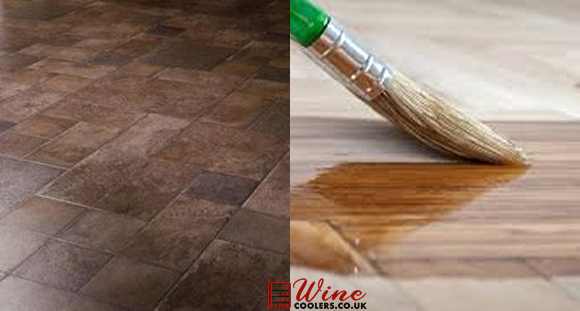
Secure your floor with a concrete sealer or use tile flooring and seal the joints with grout or tile fillers. Concrete sealing, tiles, or stones are ideal to withstand the humidity in wine storage. Avoid carpet or wood flooring, as they can absorb moisture and are difficult to maintain.
2. Framing
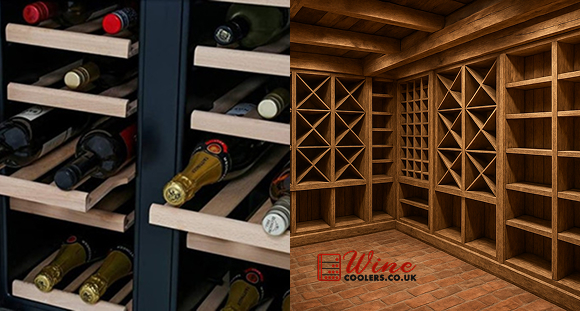
The next step of the process is to make space for insulation, called framing. In this process, we will install strips to raise surfaces or prevent dampness. You can use timber panels to frame the cellar walls. Make frames by installing furring strips made from pressure-treated timber which prevents rotting and damage to your frames.
3. Insulation
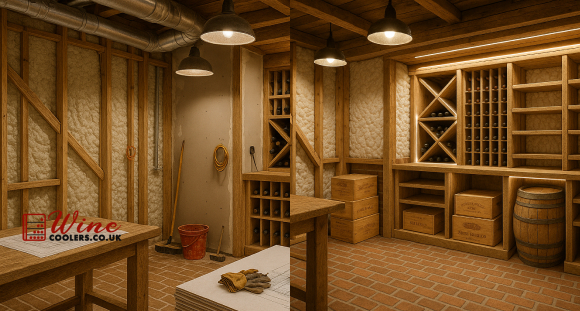
Wine rooms require consistent temperatures, and insulation helps to maintain that. Use foam board, spray foam, or fibreglass insulations to stabilise the temperature. Ensure that the foam board and the furring strips are of proper size for a completely insulated environment. This is especially important for floors, walls, and ceilings exposed to outside conditions.
4. Wall Covering
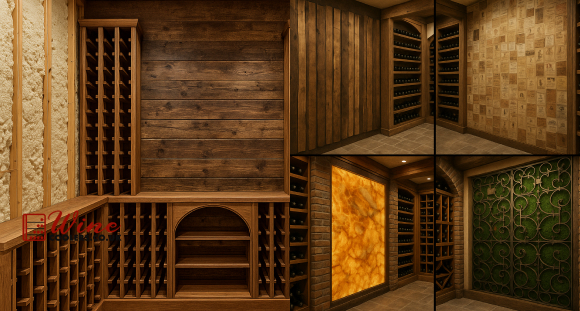
Attach a water-resistant drywall or wall covering as it can resist fungus and moisture. After attaching this, cut holes or electrical outlets and ductwork. Ensure to seal any holes created for the general outlet or light works. After installing the drywall, you can finish the walls according to your aesthetic preferences.
5. Install Cooling System
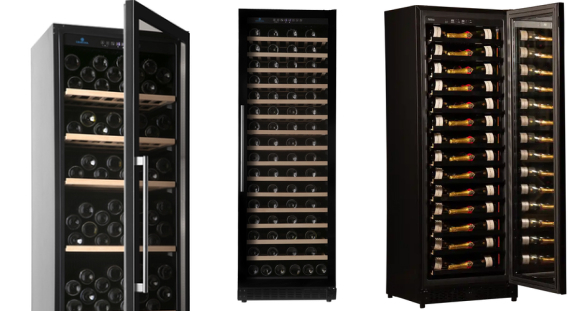
Wine cellar cooling units are the backbone of a wine cellar. If you have done all the basic preparations, it is time to install a good cooling system. A wine cellar cooling unit is specifically designed to store and preserve wine bottles in a large quantity. Maintaining consistent temperature within an ideal range without affecting external climatic changes is the major function of a cooling unit.
Depending on your space and requirements, shop for a good wine cooler/cooling system built into the room or through the wall. Check for energy efficiency to avoid too much spending on electricity bills and noise levels that may disturb your peaceful ambience.
6. Racking and Lighting
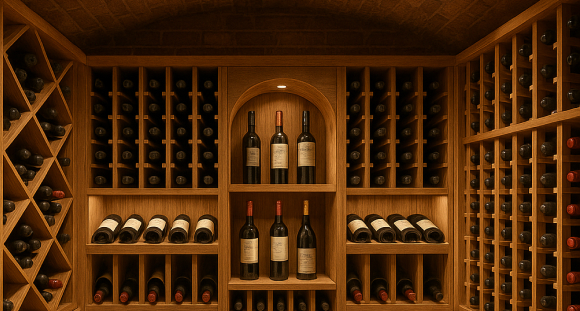
Racks or shelves are an inevitable part of your cellar. Either you can customise it or you can buy pre-assembled racks. Pre-designed racks have standard sizes and shapes that make your job easy. Customised racks are more expensive than ready-made racks, yet allow you to fit in any space you want.
High-quality wine racks are available in wood, metal, or stainless steel according to your design preference. Consider the racks that are easily accessible to your bottles and elevate your interior style.
Since your wine cellar has no natural light, introduce another lighting to the space. Avoid bright and fluorescent lights that can damage your wine by emitting heat and destroying the cool environment. Consider LED lights or dim lights that can elevate the ambience of the interior.
Now your wine room is all set to welcome your precious wine collection, and don’t forget to add some minimal classic furniture for wine tasting. Use some aesthetic or decorative elements to enhance the atmosphere, but not too much!
Conclusion
A wine cellar is not just a room, it is a haven for wine lovers to explore, discover, and indulge in the rich flavours and aromas in the comfort of your home! More than a storage room, it creates an environment that protects, preserves, and showcases your wine collection. With proper planning and execution, anyone can add value to your home by creating a perfect space for your precious wine collection.
Now let’s show off your wine collection to entertain your guests and enjoy your day!
